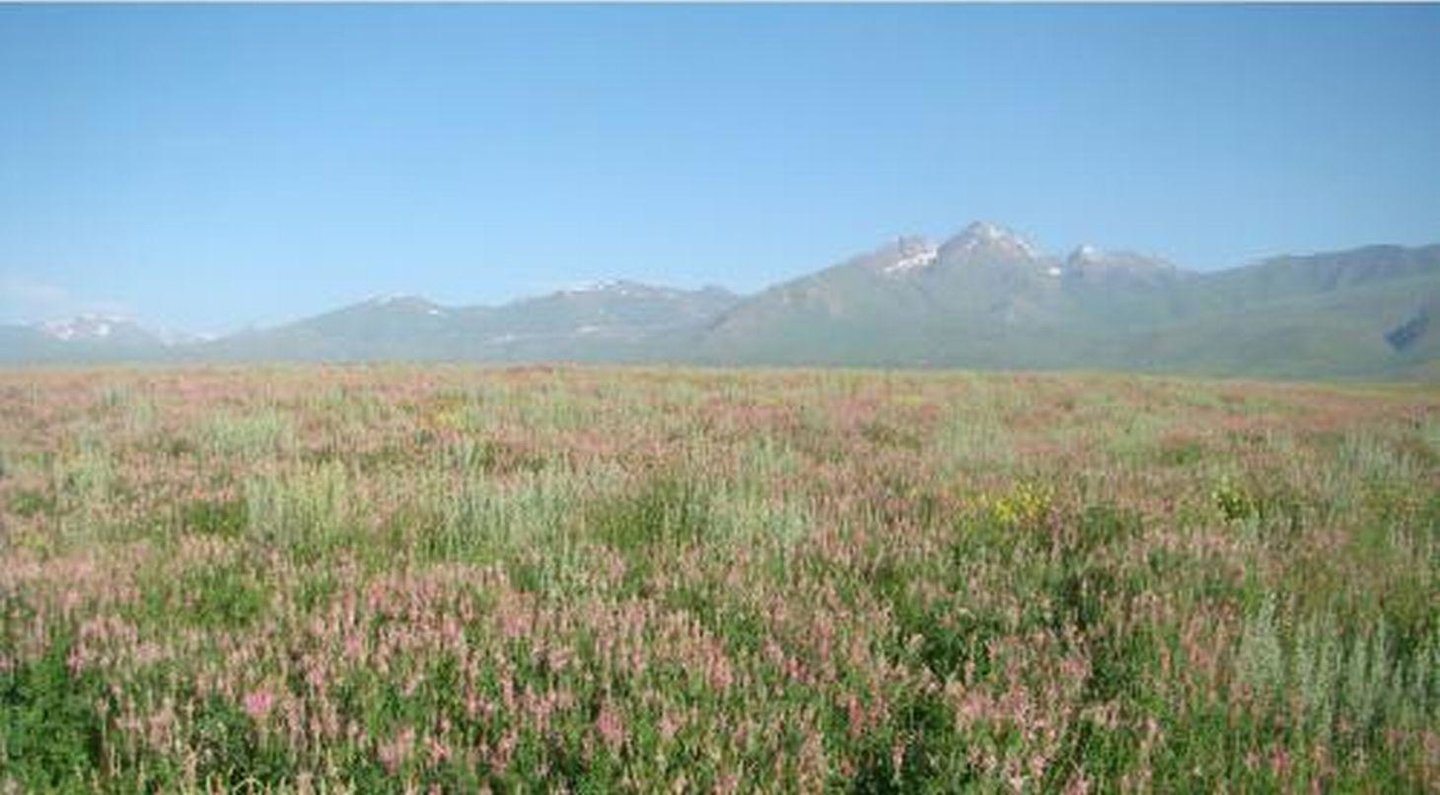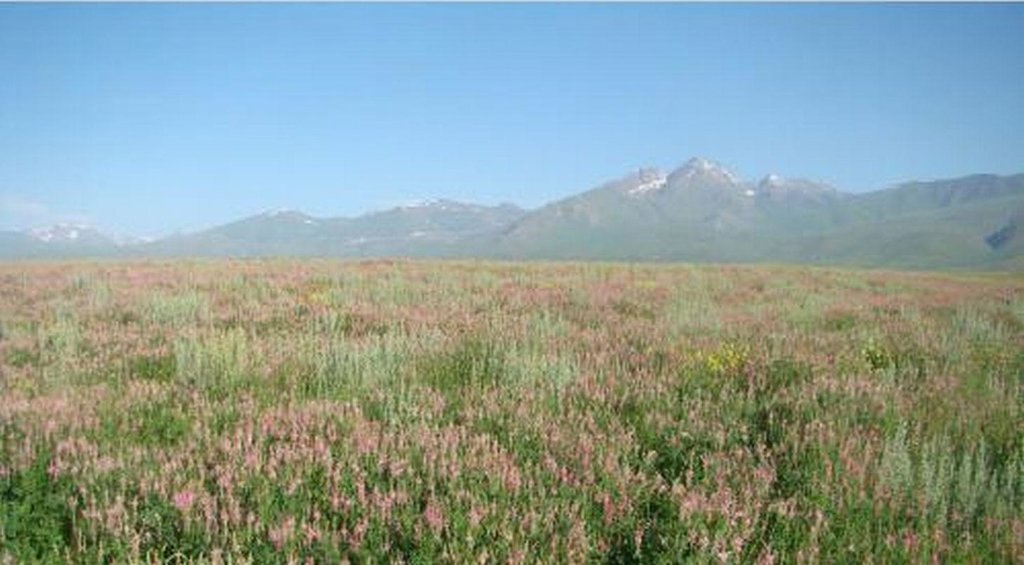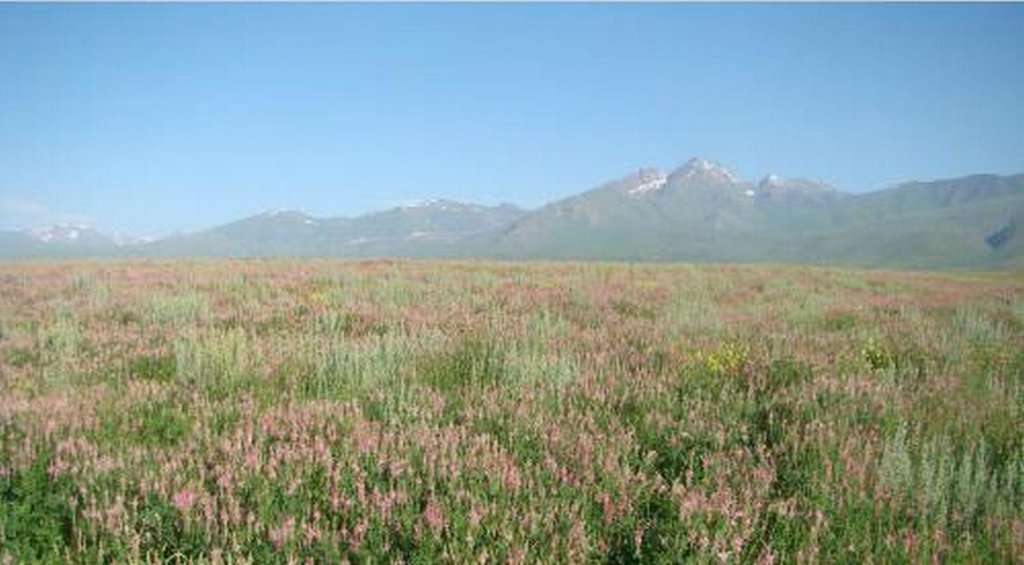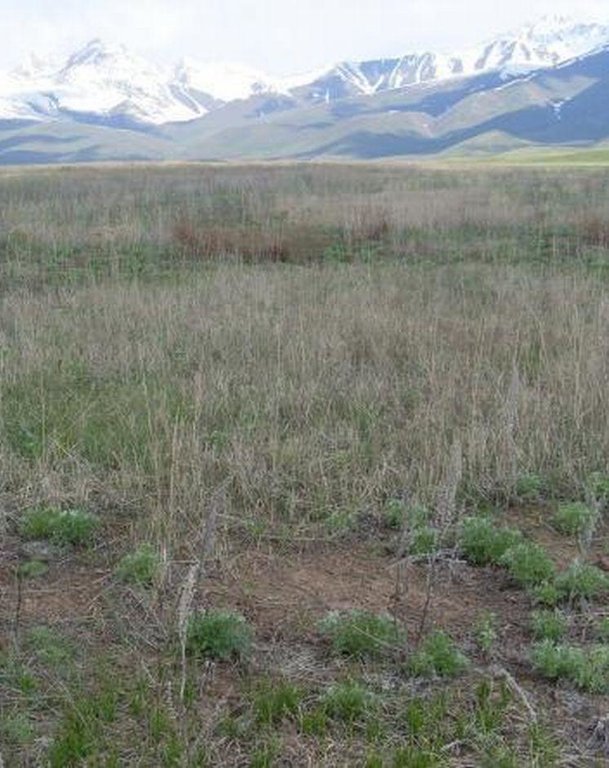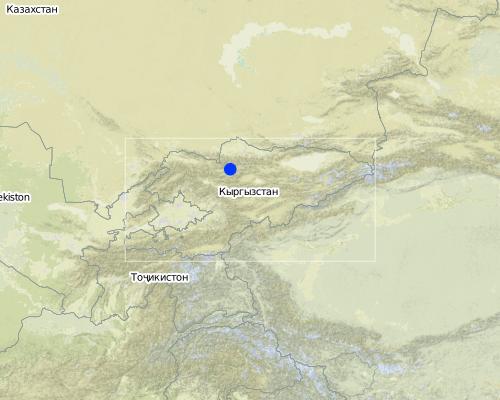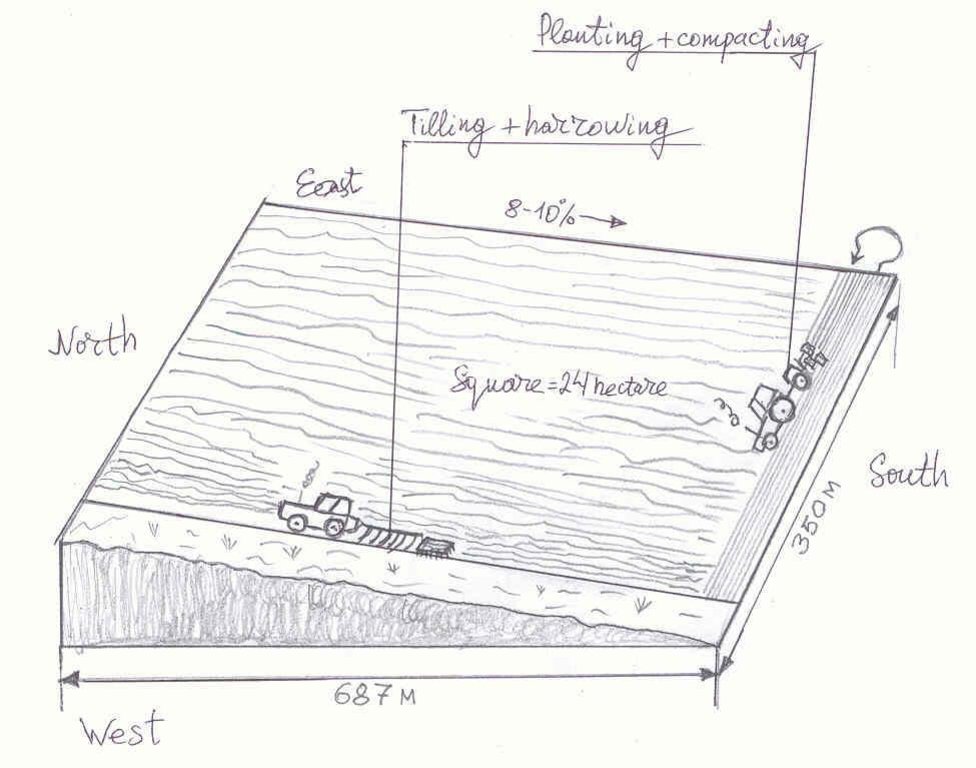Cultivation of sainfoin on high mountain pastures – Suusamyr Valley (in the frame of CACILM) [ប្រទេសកៀហ្ស៊ីស៊ីស្ថាន]
- ការបង្កើត៖
- បច្ចុប្បន្នភាព
- អ្នកចងក្រង៖ Abdybek Asanaliev
- អ្នកកែសម្រួល៖ –
- អ្នកត្រួតពិនិត្យច្រើនទៀត៖ Alexandra Gavilano, Deborah Niggli
Kyrgyzstan - Central Asian Countries Initiative for Land Management (CACILM/ИСЦАУЗР)
technologies_963 - ប្រទេសកៀហ្ស៊ីស៊ីស្ថាន
- សង្ខេបជា PDF
- សេចក្តីសង្ខេបពេញលេញជាទម្រង់ PDF សម្រាប់បោះពុម្ព
- សេចក្តីសង្ខេបពេញលេញទម្រង់អ៊ីនធឺនេត
- សេចក្តីសង្ខេបពេញលេញ (មិនមានទម្រង់ជាក់លាក់)
- Cultivation of sainfoin on high mountain pastures – Suusamyr Valley (in the frame of CACILM): 27 ខែ ធ្នូ ឆ្នាំ 2016 (inactive)
- Cultivation of sainfoin on high mountain pastures – Suusamyr Valley (in the frame of CACILM): 21 ខែ មិនា ឆ្នាំ 2017 (inactive)
- Cultivation of sainfoin on high mountain pastures – Suusamyr Valley (in the frame of CACILM): 3 ខែ សីហា ឆ្នាំ 2017 (public)
ពិនិត្យមើលគ្រប់ផ្នែក
ពង្រីកមើលទាំងអស់ បង្រួមទាំងអស់1. ព័ត៌មានទូទៅ
1.2 ព័ត៌មានលម្អិតពីបុគ្គលសំខាន់ៗ និងស្ថាប័នដែលចូលរួមក្នុងការវាយតម្លៃ និងចងក្រងឯកសារនៃបច្ចេកទេស
បុគ្គលសំខាន់ម្នាក់ (ច្រើននាក់)
អ្នកប្រើប្រាស់ដី:
Ibraimov Azimjan
Farmer in Susamyr valley
ប្រទេសកៀហ្ស៊ីស៊ីស្ថាន
អ្នកប្រើប្រាស់ដី:
Usubaliev Baibek
996 (312) 566 318
b.usubaliev@up.elcat.kg
ELCAT
Toktanaliev Street, # 4 A, room # 212,
ប្រទេសកៀហ្ស៊ីស៊ីស្ថាន
អ្នកប្រើប្រាស់ដី:
Duishenaaly uulu Urmat
Suusamyr Village
ប្រទេសកៀហ្ស៊ីស៊ីស្ថាន
ឈ្មោះគម្រោងដែលបានចងក្រងឯកសារ/ វាយតម្លៃលើបច្ចេកទេស (បើទាក់ទង)
Central Asian Countries Initiative for Land Management (CACILM I)1.3 លក្ខខណ្ឌទាក់ទងទៅនឹងការប្រើប្រាស់ទិន្នន័យដែលបានចងក្រងតាមរយៈ វ៉ូខេត
តើពេលណាដែលទិន្នន័យបានចងក្រង (នៅទីវាល)?
14/01/2011
អ្នកចងក្រង និង(បុគ្គលសំខាន់ៗ)យល់ព្រមទទួលយកនូវលក្ខខណ្ឌនានាទាក់ទងទៅនឹងការប្រើប្រាស់ទិន្នន័យដែលបានចងក្រងតាមរយៈវ៉ូខេត:
បាទ/ចា៎
1.4 សេចក្តីប្រកាសស្តីពីចីរភាពនៃការពណ៌នាពីបច្ចេកទេស
តើបច្ចេកទេសដែលបានពណ៌នានេះមានបញ្ហាដែលផ្តោតលើការធ្លាក់ចុះគុណភាពដី, បើដូច្នេះវាមិនអាចត្រូវបានប្រកាសថាជាបច្ចេកទេសនៃការគ្រប់គ្រងប្រកបដោយចីរភាពទេ?
ទេ
2. ការពណ៌នាពីបច្ចេកទេស SLM
2.1 ការពណ៌នាដោយសង្ខេបពីបច្ចេកទេស
និយមន័យបច្ចេកទេស:
Conservation of soil fertility through the cultivation of sainfoin (perennial legume plants)
2.2 ការពណ៌នាលម្អិតពីបច្ចេកទេស
ការពណ៌នា:
The Suusamyr Plain is located in the South-West of Chui Valley. Generally, this zone, located at 2000-3800 meters above sea level is used by farmers as summer pastures. Farmers are practicing agro-pastoralism by grazing animals and at the same time producing winter fodder for their livestock. They cultivate mainly barley and sometimes perennial grass.
The territory of the local administration of the Aiyl Okrug “Suusamyr” includes 6645 hectares of arable land. In 2009 about 2500 hectares were cultivated with cereals (including 1950 ha of barley) and 250 ha with sainfoin. As a result of the monoculture of cereals, weeds, pests, and insects accumulate on the fields and the soil fertility is declining. These are direct and indirect indicators of soil degradation.
The main cultivated perennial legume is sainfoin. However,farmers are short of sainfoin seeds. Most of them cultivate sainfoin for hay making and consider the seed production as non profitable.
Fallow is maintained free from weed during the vegetation season. As fallow is weed free and accumulates the soil moisture it has synergy effect to harvest high yield of barley grain. This fallow is kept during one vegetation season and applied by other farmers during next season. Crop rotation cycle is 5 years including 1 year-fallow period (1year-fallow period, 1year for barley planting and 3 years for sainfoin planting). Barley is planted into the fallow.
Sainfoin improves the soil structure as a result of high rizo-biomasses (237-333 kg/ha). Sainfoin is able to accumulate 194 -178 kg/ha of biological nitrogen providing sufficient nitrogen fertilization for two consecutive cropping seasons. Sainfoin can be cultivated at altitudes from 700 to 3400 m above sea level (G. Balian, 2004). Sainfoin is a high nectar producting crop, allowing farmers to produce 150 kg of honey from 1 hectare of sainfoin during a vegetation period. As the result of insect pollination, an increase in seed production of between 100 and 200 kg/ha has been observed.
Purpose of the Technology: Soil fertility conservation through crop rotation of barley with the perennial grass sainfoin (Onobrichis sativa).
Farmer Ibraimov Azimjan has 25 hectares of private land and rents other land from neighboring farmers. UNDP’s project procured seeds of sainfoin and covered expenditures for tillage and planting. The farmer’s responsibility is to distribute produced seeds among other farmers which are able to expand their areas under sainfoin cultivation. The farmers maintains crop rotation.
Fields are located in the foothills at an elevation of 2038-2200 m above sea level. Plowing is conducted along the slope. But planting is done across to the tilling direction, horizontally along the field (contour planting drilling). This technology increases vegetation cover and after harvesting stubbles remain
Agriculture in Suusamyr Valley is based on animal husbandry which is kept on pastures during three seasons (spring, summer and autumn). But farmers practice agro-pastorals. They have private arable land and produce cereals and forage crops. The Local Government “Suusamyr” has 6645 hectares of arable land including 561 hectares from the Distribution Found (state regulated land). Farmers are not subsidized by the Government.
The farmer Ibraimov Azimjan has 25 hectares of private land and rents other land from the neighboring farmers. In 2009 UNDP’s project procured basic seeds of sainfoin and covered the expenditures for tillage and planting. UNDP’s project organized several workshops for farmers on technology of cereals and forage crops cultivation. Project manager also had finance support in field inspection of sainfoin seed and barley.
Farmer’s responsibility is to distribute seed among other farmers which able to expand their areas under sainfoin. Farmer has resources to guard the field from grazing of animals during the vegetation period, harvest and transportation of seed. Azimjan also organized the seed cleaning and storage. Project’s management developed the rules on seed distributions and sale.
The farmer should produce sainfoin and barley in order to get benefit. Farmer’s responsibility is to distribute seed to other farmers which able to expand the area under sainfoin and barley. Name of sainfoin variety is “Belek”, barley variety is “Kylym”, they are developed in research centers of Kyrgyz Republic.
The population of the Aiyl Okrug “Suusamyr” is 6400. The Local Government has no human resources for field activities. There are six villages at the territory of this Local Government. All fields and villages are connected by dirt roads. The electricity is supplied on regularly basis. People have drinking water supplies.
Farmer’s fields are located at foothills of 2038-2200 m above sea level. The type of land use is rainfed. Some irrigated channels which were developed in Soviet time are destroyed now. The fields are infested mainly with wild Oat, Couch-grass, spp. pigweed, wormwood and others.
The farmers cultivate cereals as monoculture. Some of them plant the sainfoin. Additionally, farmers cultivate potato on a total area of 180-200 hectares. The varieties are from local breeders (Nevsky, Cardinal) and introduced varieties from seed Firm “Agrico” and “NZPC” (Picasso, Sante and Mondial).
The main type of soil is chestnut (light chestnut soil and dark chestnut soil). The potential fertility of these soils is high but due to the lack of crop rotation, plant protection activities, fertilizer application, soil degradation is going on. There are no soil maps in the office of local administration except for those which were developed during the Soviet time.
2.3 រូបភាពនៃបច្ចេកទេស
2.5 ប្រទេស/តំបន់/ទីតាំងកន្លែង ដែលបច្ចេកទេសត្រូវបានអនុវត្ត និងបានគ្រប់ដណ្តប់ដោយការវាយតម្លៃនេះ
ប្រទេស:
ប្រទេសកៀហ្ស៊ីស៊ីស្ថាន
តំបន់/រដ្ឋ/ខេត្ត:
Kyrgyz Republic, Chui oblast
បញ្ជាក់បន្ថែមពីលក្ខណៈនៃទីតាំង:
Jayl district
មតិយោបល់:
Boundary points of the Technology area: The sainfoin is cultivated on mountain pastures from 800 meters to 3000 meters above sea level
Map
×2.6 កាលបរិច្ឆេទនៃការអនុវត្ត
ប្រសិនបើមិនច្បាស់ឆ្នាំ សូមបញ្ជាក់កាលបរិច្ឆេទដែលប្រហាក់ប្រហែល:
- តិចជាង 10ឆ្នាំមុន (ថ្មី)
2.7 ការណែនាំពីបច្ចេកទេស
សូមបញ្ជាក់តើបច្ចេកទេសត្រូវបានណែនាំឱ្យអនុវត្តដោយរបៀបណា:
- តាមរយៈគម្រោង / អន្តរាគមន៍ពីខាងក្រៅ
មតិយោបល់ (ប្រភេទនៃគម្រោង ។ល។):
The Technology was developed by the Kyrgyz Livestock and Pasture Research Institute and applied by the UNDP Project "Demonstration Sustainable Mountain Pasture Management in Suusamyr Valley, Kyrgyzstan"
3. ចំណាត់ថ្នាក់នៃបច្ចេកទេស SLM
3.1 គោលបំណងចម្បង (១ ឬច្រើន) នៃបច្ចេកទេសនេះ
- បង្កើតផលប្រយោជន៍សេដ្ឋកិច្ច
3.2 ប្រភេទដីប្រើប្រាស់មួយប្រភេទ (ច្រើនប្រភេទ) ដែលបានអនុវត្តបច្ចេកទេស

ដីដាំដំណាំ
- ដំណាំប្រចាំឆ្នាំ
- ដំណាំរយៈពេលវែង (មិនមែនឈើ)

ដីសម្រាប់ចិញ្ចឹមសត្វ
ដីវាលស្មៅធំៗ:
- ពាក់កណ្តាលពនេចរ
- បែងចែកវាលស្មៅជាប្លុក
ដីវាលស្មៅតូចៗ/ ផលិតកម្មចំណី:
- បង្កើនវាលស្មៅ
- agro-pastoralism
មតិយោបល់:
Major land use problems (compiler’s opinion): Decline of soil fertility due to longstanding cultivation of barley on the field. Annual conventional plowing is affecting the mineralization of soil humus.
Major land use problems (land users’ perception): Decline of barley yield. The quality of barley grain also is declining.
Future (final) land use (after implementation of SLM Technology): Cropland: Cp: Perennial (non-woody) cropping
Livestock is grazing on crop residues
3.3 ព័ត៌មានបន្ថែមអំពីអ្នកប្រើប្រាស់ដី
ការផ្គត់ផ្គង់ទឹកនៅកន្លែងអនុវត្តបច្ចេកទេស:
- ទឹកភ្លៀង និងប្រព័ន្ធស្រោចស្រព
ចំនួនសារដែលដាំដំណាំក្នុងមួយឆ្នាំ:
- 1
សូមបញ្ជាក់:
Longest growing period in days: 120, Longest growing period from month to month: April - August
ដង់ស៊ីតេនៃសត្វចិញ្ចឹម (បើពាក់ព័ន្ធ):
25-50 LU /km2
3.5 ការសាយភាយនៃបច្ចេកទេស
បញ្ជាក់ពីការសាយភាយនៃបច្ចេកទេស:
- ត្រូវបានផ្សព្វផ្សាយត្រឹមតំបន់មួយ
ប្រសិនបើបច្ចេកទេសត្រូវបានសាយភាយពាសពេញតំបន់ណាមួយ សូមកំណត់ទំហំផ្ទៃដីអនុវត្តន៍:
- 0.1-1 គម2
មតិយោបល់:
Total area covered by the SLM Technology is 0,24 m2.
3.6 វិធានការ SLM ដែលបញ្ចូលនូវបច្ចេកទេស

វិធានការក្សេត្រសាស្ត្រ
- A1: ដំណាំ/គម្របដី
- A3: ការរក្សាស្រទាប់ដីខាងលើ

វិធានការរុក្ខជាតិ
- V2: ស្មៅនិងរុក្ខជាតិៗដែលដុះមានអាយុមិនលើសពី 2ឆ្នាំ
3.7 កំណត់ប្រភេទនៃការធ្លាក់ចុះគុណភាពដីសំខាន់ៗដែលបច្ចេកទេសនេះបានដោះស្រាយ

ការធ្លាក់ចុះសារធាតុគីមីក្នុងដី
- Cn: ការថយចុះជីជាតិ និងកាត់បន្ថយបរិមាណសារធាតុសរីរាង្គ (មិនកើតឡើងដោយការហូរច្រោះទេ)

ការធ្លាក់ចុះជីវសាស្ត្រនៃដី
- Bc: ការថយចុះនូវគម្របរុក្ខជាតិ
- Bh: ការបាត់បង់ទីជំរក
មតិយោបល់:
Main causes of degradation: soil management (Lack of fertilizes), over-exploitation of vegetation for domestic use, Heavy / extreme rainfall (intensity/amounts) (Usually in dry weather plants have a vertical appearance. After heavy gales they lose their vetical standing and they droop. This is lodging. During lodginh of plants the yield of seed is decreasing.), land tenure
Secondary causes of degradation: crop management (annual, perennial, tree/shrub) (As a result of the monoculture of cereals, weeds, pests, and insects accumulate on the fields and the soil fertility is declining.), other human induced causes (specify) (inappropriate soil management)
3.8 ការពារ កាត់បន្ថយ ឬស្តារឡើងវិញនៃការធ្លាក់ចុះគុណភាពដី
បញ្ជាក់ពីគោលដៅរបស់បច្ចេកទេស ដែលផ្តោតទៅការធ្លាក់ចុះគុណភាពដី:
- ការកាត់បន្ថយការធ្លាក់ចុះគុណភាពដី
- ការជួសជុល/ ស្តារឡើងវិញនៃឱនភាពដីធ្ងន់ធ្ងរ
4. បច្ចេកទេសជាក់លាក់ សកម្មភាពអនុវត្ត ធាតុចូល និងថ្លៃដើម
4.1 គំនូសបច្ចេកទេសនៃបច្ចេកទេសនេះ
4.2 លក្ខណៈពិសេសនៃបច្ចេកទេស/ ពណ៌នាពីគំនូរបច្ចេកទេស
Fields are located on South exposition of the foothills of the Kyrgyz Ala-Too Mountains in the Northern part of the Suusamyr valley. The length of the sainfoin field is 687 meters, and its width is 350 meters. Slope steepness is 8-10 %.
Tilling is conducted along the slope by a tractor K-700, with harrowing being conducted at the same time. The depth of tilling is 20-22 cm. Planting is conducted across to plowing direction. The date for sainfoin sowing is the first ten days of May. The seeds required are 80 kg/ha. Depth of sowing is 4 cm. This field is situated 8 kilometers from central Suusamyr village, reachable on a bad dirt road.
Location: Suusamyr Valley. Jaiyl raion / Chui oblast / Kyrgyzstan
Date: 11.01.2011
Technical knowledge required for field staff / advisors: high (Special training is requested)
Technical knowledge required for land users: low (Field demonstration is needed)
Main technical functions: control of dispersed runoff: impede / retard, stabilisation of soil (eg by tree roots against land slides), increase in organic matter, increase in nutrient availability (supply, recycling,…)
Secondary technical functions: improvement of subsoil structure (hardpan)
Vegetative measure: field planted by perennual grass
Vegetative material: C : perennial crops
Number of plants per (ha): 3000000
Spacing between rows / strips / blocks (m): 0.15
Width within rows / strips / blocks (m): 0.15
Vegetative measure: Vegetative material: C : perennial crops
Perennial crops species: Sainfoin os sowed with planting machine C3-3.6. The distance between colters is 15 cm.
4.3 ព័ត៌មានទូទៅដែលពាក់ព័ន្ធនឹងការគណនាធាតុចូល និងថ្លៃដើម
ផ្សេងៗ/ រូបិយប័ណ្ណជាតិ (បញ្ជាក់):
KGS
កំណត់អត្រាប្តូរប្រាក់ពីដុល្លាទៅរូបិយប័ណ្ណតំបន់ (បើទាក់ទង)៖ 1 ដុល្លារ =:
45,0
កំណត់ថ្លៃឈ្នួលជាមធ្យមនៃការជួលកម្លាំងពលកម្មក្នុងមួយថ្ងៃ:
8.00
4.4 សកម្មភាពបង្កើត
| សកម្មភាព | ប្រភេទវិធានការ | ពេលវេលា | |
|---|---|---|---|
| 1. | Tilling | សារពើរុក្ខជាតិ | End of April. Once in 3 years |
| 2. | Planting | សារពើរុក្ខជាតិ | End of April. Once in 3 years |
4.5 ថ្លៃដើម និងធាតុចូលដែលត្រូវការសម្រាប់ការបង្កើតបច្ចេកទេស
| បញ្ជាក់ពីធាតុចូល | ឯកតា | បរិមាណ | ថ្លៃដើមក្នុងមួយឯកតា | ថ្លៃធាតុចូលសរុប | % នៃថ្លៃដើមដែលចំណាយដោយអ្នកប្រើប្រាស់ដី | |
|---|---|---|---|---|---|---|
| កម្លាំងពលកម្ម | establishment costs | hectare | 1,0 | 187,0 | 187,0 | |
| កម្លាំងពលកម្ម | labour | person/hour | 0,8 | 128,0 | 102,4 | 100,0 |
| សម្ភារៈដាំដុះ | seeds | hecatre | 1,0 | 108,0 | 108,0 | |
| សម្ភារៈដាំដុះ | seeds | kg | 75,0 | 2600,0 | 195000,0 | |
| ផ្សេងៗ | fuel | liter | 58,0 | 321,0 | 18618,0 | |
| ថ្លៃដើមសរុបក្នុងការបង្កើតបច្ចេកទេស | 214015,4 | |||||
មតិយោបល់:
Duration of establishment phase: 1 month(s)
4.6 សកម្មភាពថែទាំ
| សកម្មភាព | ប្រភេទវិធានការ | ពេលវេលា/ ភាពញឹកញាប់ | |
|---|---|---|---|
| 1. | Harvesting | សារពើរុក្ខជាតិ | annually |
| 2. | Cleaning of seed | សារពើរុក្ខជាតិ | annually |
| 3. | Cleaning of seed | សារពើរុក្ខជាតិ |
4.7 កំណត់ថ្លៃដើមសម្រាប់ការថែទាំ/ សកម្មភាពរបស់បច្ចេកទេស (ក្នុងរយៈពេលមួយឆ្នាំ)
មតិយោបល់:
Machinery/ tools: Tractor MTZ-80, Self-Proppeled Combine Enisey-600, Seed Cleaning Machine SM-4
The above costs were affected by the length of the field and number of turn points during tilling and planting.
4.8 កត្តាសំខាន់បំផុតដែលមានឥទ្ធិពលដល់ការចំណាយ
ពណ៌នាពីកត្តាប៉ះពាល់ចម្បងៗទៅលើថ្លៃដើម:
The price of sainfoin seeds is very high. The slope is increasing the fuel consumption of the tractor, and prices for fuel are raising. Contour tilling (also planting) by big tractor (K-700) is further increasing fuel consumption, because the number of turning-points are increased. Soil depth is not increasing cost in a major way, because soil structure in the area is comparatively good and the tractor is powerful.
All costs are calculated for 1 hectare of sainfoin. National currency is KGS. Exchange rate was approximately 45 KGS for 1 US Dollar in 2009 and 2010.
5. លក្ខណៈបរិស្ថានធម្មជាតិ និងមនុស្ស
5.1 អាកាសធាតុ
បរិមាណទឹកភ្លៀងប្រចាំឆ្នាំ
- < 250 មម
- 251-500 មម
- 501-750 មម
- 751-1,000 មម
- 1,001-1,500 មម
- 1,501-2,000 មម
- 2,001-3,000 មម
- 3,001-4,000 មម
- > 4,000 មម
តំបន់កសិអាកាសធាតុ
- មានភ្លៀងមធ្យម
Thermal climate class: temperate
5.2 សណ្ឋានដី
ជម្រាលជាមធ្យម:
- រាបស្មើ (0-2%)
- ជម្រាលតិចតួច (3-5%)
- មធ្យម (6-10%)
- ជម្រាលខ្ពស់បន្តិច (11-15%)
- ទីទួល (16-30%)
- ទីទួលចោត (31-60%)
- ទីទួលចោតខ្លាំង (>60%)
ទម្រង់ដី:
- ខ្ពង់រាប
- កំពូលភ្នំ
- ជម្រាលភ្នំ
- ជម្រាលទួល
- ជម្រាលជើងភ្នំ
- បាតជ្រលងភ្នំ
តំបន់តាមរយៈកម្ពស់ :
- 0-100 ម
- 101-500 ម
- 501-1,000 ម
- 1,001-1,500 ម
- 1,501-2,000 ម
- 2,001-2,500 ម
- 2,501-3,000 ម
- 3,001-4,000 ម
- > 4,000 ម
5.3 ដី
ជម្រៅដីជាមធ្យម:
- រាក់ខ្លាំង (0-20 សម)
- រាក់ (21-50 សម)
- មធ្យម (51-80 សម)
- ជ្រៅ (81-120 សម)
- ជ្រៅខ្លាំង (> 120 សម)
វាយនភាពដី (ស្រទាប់លើ):
- គ្រើម/ មានពន្លឺ (ខ្សាច់)
- មធ្យម (ល្បាយ, ល្បាប់)
វាយនភាពដី (> 20 សម ស្រទាប់ក្នុង):
- គ្រើម/ មានពន្លឺ (ខ្សាច់)
- មធ្យម (ល្បាយ, ល្បាប់)
សារធាតុសរីរាង្គនៅស្រទាប់ដីខាងលើ:
- ខ្ពស់ (>3%)
- មធ្យម (1-3%)
បើអាចសូមភ្ជាប់ការពណ៌នាពីដីឱ្យបានច្បាស់ ឬព័ត៌មានដែលអាចទទួលបាន ឧ. ប្រភេទដី, pH ដី/ ជាតិអាស៊ីត, សមត្ថភាពផ្លាស់ប្តូរកាចុង, វត្តមាននីត្រូសែន, ភាពប្រៃ ។ល។:
medium-high soil fertility, soil water storage = medium, soil drainage = good
5.4 ទឹកដែលអាចទាញមកប្រើប្រាស់បាន និងគុណភាពទឹក
នីវ៉ូទឹកក្រោមដី:
5-50 ម
ទឹកលើដីដែលអាចទាញយកប្រើប្រាស់បាន:
ល្អ
គុណភាពទឹក (មិនបានធ្វើប្រត្តិកម្ម):
ទឹកពិសារដែលមានគុណភាពល្អ
តើមានបញ្ហាភាពទឹកប្រៃហូរចូលមកដែរឬទេ?
ទេ
5.5 ជីវៈចម្រុះ
ភាពសម្បូរបែបនៃប្រភេទ:
- កម្រិតមធ្យម
ភាពសម្បូរបែបនៃទីជម្រក:
- កម្រិតមធ្យម
មតិយោបល់ និងលក្ខណៈពិសេសផ្សេងទៀតលើជីវចម្រុះ:
Earthworms and gnawing animals inhabit on the field
5.6 លក្ខណៈនៃអ្នកប្រើប្រាស់ដីដែលអនុវត្តបច្ចេកទេស
នៅមួយកន្លែង ឬពនេចរ :
- ពាក់កណ្តាលពនេចរ
- ពនេចរ
ទីផ្សារនៃប្រព័ន្ធផលិតកម្ម:
- សម្រាប់ហូបក្នុងគ្រួសារ (ផ្គត់ផ្គង់ខ្លួនឯង)
- ពាក់កណ្តាលពាណិជ្ជកម្ម (ផ្គត់ផ្គង់ខ្លួនឯង/ ពាណិជ្ជកម្ម
ចំណូលក្រៅកសិកម្ម:
- តិចជាង 10% នៃចំណូល
កម្រិតជីវភាព:
- មធ្យម
- មានខ្លាំង
ឯកជន ឬក្រុម:
- ជាក្រុម/ សហគមន៍
កម្រិតប្រើប្រាស់គ្រឿងយន្ត:
- គ្រឿងយន្ត/ ម៉ាស៊ីន
យេនឌ័រ:
- ស្ត្រី
- បុរស
សូមបញ្ជាក់ពីលក្ខណៈពាក់ព័ន្ធផ្សេងទៀតអំពីអ្នកប្រើប្រាស់ដី:
Land users applying the Technology are mainly common / average land users
Difference in the involvement of women and men: This technology is very strongly supported by Pasture Users Association, who is interesting in improving forage quantity and quality. Sainfoin's hay has high protein content in comparison with natural hay. Therefore the association is interested in expansion of sainfoin fields.
Population density: < 10 persons/km2
Annual population growth: 1% - 2%
Off-farm income specification: Some farmers sell agricultural and processing products in the shops located along the highway Bishkek-Osh and in the villages. Some of the villagers provide taxi services from Suusamyr to Bishkek.
5.7 ទំហំផ្ទៃដីជាមធ្យមនៃដីផ្ទាល់ខ្លួន ឬជួលគេដែលបានអនុវត្តបច្ចេកទេស
- < 0.5 ហិកតា
- 0.5-1 ហិកតា
- 1-2 ហិកតា
- 2-5 ហិកតា
- 5-15 ហិកតា
- 15-50 ហិកតា
- 50-100 ហិកតា
- 100-500 ហិកតា
- 500-1,000 ហិកតា
- 1,000-10,000 ហិកតា
- > 10,000 ហិកតា
តើផ្ទៃដីនេះចាត់ទុកជាទំហំកម្រិតណាដែរ ខ្នាតតូច មធ្យម ឬខ្នាតធំ (ធៀបនឹងបរិបទតំបន់)?
- ខ្នាតមធ្យម
5.8 ភាពជាម្ចាស់ដី កម្មសិទ្ធប្រើប្រាស់ដី និងកម្មសិទ្ធប្រើប្រាស់ទឹក
ភាពជាម្ចាស់ដី:
- រដ្ឋ
- ឯកជន មានកម្មសិទ្ធ
កម្មសិទ្ធិប្រើប្រាស់ដី:
- ឯកជន
កម្មសិទ្ធប្រើប្រាស់ទឹក:
- ជាក្រុម (មានដែនកំណត់)
5.9 ការប្រើប្រាស់សេវាកម្ម និងហេដ្ឋារចនាសម្ព័ន្ធ
សុខភាព:
- មិនល្អ
- មធ្យម
- ល្អ
ការអប់រំ:
- មិនល្អ
- មធ្យម
- ល្អ
ជំនួយបច្ចេកទេស:
- មិនល្អ
- មធ្យម
- ល្អ
ការងារ (ឧ. ការងារក្រៅកសិដ្ឋាន):
- មិនល្អ
- មធ្យម
- ល្អ
ទីផ្សារ:
- មិនល្អ
- មធ្យម
- ល្អ
ថាមពល:
- មិនល្អ
- មធ្យម
- ល្អ
ផ្លូវ និងការដឹកជញ្ជូន:
- មិនល្អ
- មធ្យម
- ល្អ
ទឹកផឹក និងអនាម័យ:
- មិនល្អ
- មធ្យម
- ល្អ
សេវាកម្មហិរញ្ញវត្ថុ:
- មិនល្អ
- មធ្យម
- ល្អ
Extension Service:
- មិនល្អ
- មធ្យម
- ល្អ
6. ផលប៉ះពាល់ និងការសន្និដ្ឋាន
6.1 ផលប៉ះពាល់ក្នុងបរិវេណអនុវត្តបច្ចេកទេសដែលកើតមាន
ផលប៉ះពាល់លើសេដ្ឋកិច្ចសង្គម
ផលិតផល
ផលិតកម្មដំណាំ
គុណភាពមុន SLM:
19 c/ha
គុណភាពក្រោយ SLM:
23 c/ha
ផលិតកម្មចំណីសត្វ
គុណភាពមុន SLM:
500 bales
គុណភាពក្រោយ SLM:
550 bales
គុណភាពចំណីសត្វ
ចំណូល និងថ្លៃដើម
ការចំណាយលើធាតុចូលកសិកម្ម
គុណភាពមុន SLM:
0
គុណភាពក្រោយ SLM:
24 ha
ភាពសម្បូរបែបប្រភពប្រាក់ចំណូល
ផលប៉ះពាល់ទៅលើវប្បធម៌សង្គម
សន្តិសុខស្បៀង/ ភាពគ្រប់គ្រាន់ខ្លួនឯង
ឱកាសវប្បធម៍
ស្ថាប័នសហគមន៍
គុណភាពមុន SLM:
0
គុណភាពក្រោយ SLM:
1
ការកាត់បន្ថយជម្លោះ
គុណភាពមុន SLM:
0
គុណភាពក្រោយ SLM:
2 training
ផលប៉ះពាល់ទៅលើអេកូឡូស៊ី
វដ្តទឹក/លំហូរ
លំហូរទឹកលើផ្ទៃដី
ដី
គម្របដី
គុណភាពមុន SLM:
80%
គុណភាពក្រោយ SLM:
95%
ដីហាប់
សារធាតុសរីរាង្គដី/ការបូនក្រោមដី
ជីវចម្រុះ៖ ដំណាំ, សត្វ
ភាពសម្បូរបែបនៃទីជំរក
6.2 ផលប៉ះពាល់ក្រៅបរិវេណអនុវត្តបច្ចេកទេសដែលកើតមាន
Buffering/សមត្ថភាពចម្រោះ
ខូចខាតដល់ស្រែអ្នកជិតខាង
គុណភាពក្រោយ SLM:
5ha
មតិយោបល់/ ការបញ្ជាក់:
Project recruts a security guard to protect sainfoin field since May. And at the same time he watches the neighbours fields.Therefore damage on it is reduced.
Honey collection is improved
6.3 ភាពប្រឈម និងភាពរួសនៃបច្ចេកទេសទៅនឹងការប្រែប្រួលអាកាសធាតុ និងគ្រោះអាកាសធាតុ/ គ្រោះមហន្តរាយ (ដែលដឹងដោយអ្នកប្រើប្រាស់ដី)
ការប្រែប្រួលអាកាសធាតុ
ការប្រែប្រួលអាកាសធាតុ
| រដូវកាល | ប្រភេទនៃការប្រែប្រួលអាកាសធាតុ/ព្រឹត្តិការណ៍ | លក្ខណៈឆ្លើយតបនៃបច្ចេកទេសទៅនឹងការប្រែប្រួលអាកាសធាតុ | |
|---|---|---|---|
| សីតុណ្ហភាពប្រចាំឆ្នាំ | កើនឡើង | មិនល្អ |
គ្រោះអាកាសធាតុ (មហន្តរាយ)
គ្រោះមហន្តរាយធម្មជាតិ
| លក្ខណៈឆ្លើយតបនៃបច្ចេកទេសទៅនឹងការប្រែប្រួលអាកាសធាតុ | |
|---|---|
| ព្យុះភ្លៀងតាមតំបន់ | ល្អ |
គ្រោះមហន្តរាយអាកាសធាតុ
| លក្ខណៈឆ្លើយតបនៃបច្ចេកទេសទៅនឹងការប្រែប្រួលអាកាសធាតុ | |
|---|---|
| រាំងស្ងួត | ល្អ |
គ្រោះមហន្តរាយទឹក
| លក្ខណៈឆ្លើយតបនៃបច្ចេកទេសទៅនឹងការប្រែប្រួលអាកាសធាតុ | |
|---|---|
| ទឹកជំនន់ទូទៅ (ទន្លេ) | មិនល្អ |
ផលវិបាកដែលទាក់ទងនឹងបរិយាកាសផ្សេងៗទៀត
ផលវិបាកដែលទាក់ទងនឹងបរិយាកាសផ្សេងៗទៀត
| លក្ខណៈឆ្លើយតបនៃបច្ចេកទេសទៅនឹងការប្រែប្រួលអាកាសធាតុ | |
|---|---|
| កាត់បន្ថយពេលដាំដុះ | មិនល្អ |
6.4 ការវិភាគថ្លៃដើម និងអត្ថប្រយោជន៍
តើផលចំណេញ និងថ្លៃដើមត្រូវបានប្រៀបធៀបគ្នាយ៉ាងដូចម្តេច (ទស្សនៈរបស់អ្នកប្រើប្រាស់ដី)?
រយៈពេលខ្លី:
វិជ្ជមានខ្លាំង
រយៈពេលវែង:
វិជ្ជមានខ្លាំង
តើផលចំណេញ និងការថែទាំ/ ជួសជុលត្រូវបានប្រៀបធៀបគ្នាយ៉ាងដូចម្តេច (ទស្សនៈរបស់អ្នកប្រើប្រាស់ដី)?
រយៈពេលខ្លី:
វិជ្ជមាន
រយៈពេលវែង:
វិជ្ជមាន
6.5 ការទទួលយកបច្ចេកទេស
- តែមួយករណី /ពិសោធន៍
ក្នុងចំណោមគ្រួសារទាំងអស់ដែលអនុវត្តបច្ចេកទេស តើមានប៉ុន្មានគ្រួសារដែលចង់ធ្វើដោយខ្លួនឯង ដោយមិនទទួលបានសម្ភារៈលើកទឹកចិត្ត/ប្រាក់ឧបត្ថម្ភ?:
- 0-10%
មតិយោបល់:
1% of land user families have adopted the Technology with external material support
1 land user families have adopted the Technology with external material support
Comments on acceptance with external material support: Saifoin seed was provided to farmers with lower price than commercially available seeds.
Comments on spontaneous adoption: There is little trend towards (growing) spontaneous adoption of the technology.
There is a little trend towards spontaneous adoption of the Technology. Some farmers are aware about the production of high quality forage and want to be ready to be protected from drought. During drought periods the yield of natural vegetation is less, but the yield of sainfoin’ is constant.
6.7 ភាពខ្លាំង/ គុណសម្បត្តិ/ ឱកាសនៃបច្ចេកទេស
| ភាពខ្លាំង/ គុណសម្បត្តិ/ ឱកាសនៅកន្លែងរបស់អ្នកប្រើប្រាស់ដី |
|---|
| Keeping the fields as fallow is not profitable for ordinary farmers. It can be done by rich farmers. |
| There is need in subsidies from the Government in order to distribute cereals and perennial legume seed. |
| If there is enough fuel and seed farmers can cultivate sainfoin everywhere, it is very good technology. |
| ភាពខ្លាំង/ គុណសម្បត្តិ/ ឱកាស ទស្សនៈរបស់បុគ្គលសំខាន់ៗ |
|---|
| The winter is very hard in Suusamyr Valley and livestock need enough and quality forage. Sainfoin hay contains high level of protein. |
| Natural vegetation yields for hay making is not so big particularly in drought period. Sainfoin is very productive crop. |
| Rizo biomass of sainfoin is big and it accumulates the nitrogen. Sainfoin improves the soil fertility. |
| Sainfoin is income generating crop because after harvesting of seed sainfoin the straw can be also sold by farmers at the price of 50 som for one hay bale |
| This Technology also protects the soil surface from the erosion in the result of strong density of plants. |
6.8 ភាពខ្សោយ/ គុណវិបត្តិ/ ហានិភ័យនៃបច្ចេកទេស និងវិធីសាស្ត្រដោះស្រាយ
| ភាពខ្សោយ/ គុណវិបត្តិ/ ហានិភ័យ ទស្សនៈរបស់អ្នកប្រើប្រាស់ដី | តើបច្ចេកទេសទាំងនោះបានដោះស្រាយបញ្ហាដូចម្តេច? |
|---|---|
| Poor farmer is not interested in the Conservation Technology | Awareness raising of the poor farmers is necessary |
| We are having not enough knowledge about the soil conservation possibility legumes | To organize the training of farmers. |
| State legislation about soil protection is not maintained by Local Government and farmers | To monitor the observation of legislation by land users and local authorities |
| There should be Soil fertility protection service. | The Government should finance the establishment of service on soil fertility protection. |
| ភាពខ្សោយ/ គុណវិបត្តិ/ ហានិភ័យ ទស្សនៈរបស់អ្នកចងក្រងឬបុគ្គលសំខាន់ៗ | តើបច្ចេកទេសទាំងនោះបានដោះស្រាយបញ្ហាដូចម្តេច? |
|---|---|
| Lack of good credit system for farmers SWCT. | To lower interest rates of credits while lending farmers for implementation of the Conservation Technology |
| Comparatively high price of certified sainfoin seeds are not available for farmers | Usage of not certified seed by farmers leads to poor yields of sainfoin and cereals. To ensure the supply of high quality seed through distributers’ centers |
| Farmers need special knowledge in order to produce sainfoin seed | To conduct trainings for farmers on seed production technologies. |
|
To consolidate farmers about the effect of sainfoin cultivation for soil fertility some scientists have to do on farm demonstration plots |
Extension services should organize demonstration fields in villages. |
7. ឯកសារយោង និងវេបសាយ
7.1 វិធីសាស្ត្រ/ ប្រភពនៃព័ត៌មាន
- តាមការចុះទីវាល ការស្រាវជ្រាវនៅទីវាល
- ការសម្ភាសន៍ជាមួយអ្នកប្រើប្រាស់ដី
7.2 ឯកសារយោងដែលបានចេញផ្សាយ
ចំណងជើង អ្នកនិពន្ធ ឆ្នាំ ISBN:
Usubaliev B. Annual project activity’s report. “Demonstration sustainable mountains pasture management in the Suusamyr Valley. Kyrgyzstan”. UNDP.- Kyrgyzsran., 2010. Bishkek.
មានប្រភពមកពីណា? ថ្លៃដើមប៉ុន្មាន?
Project office
ចំណងជើង អ្នកនិពន្ធ ឆ្នាំ ISBN:
Duishenaaly uulu Urmat.- Report of land management specialist of the “Local Gogernment Suusamyr”, 2010
មានប្រភពមកពីណា? ថ្លៃដើមប៉ុន្មាន?
Suusamyr Village
ចំណងជើង អ្នកនិពន្ធ ឆ្នាំ ISBN:
Bekganov Nurkan.- Report of local mobilization specialist of the UNDP project.- 2010
មានប្រភពមកពីណា? ថ្លៃដើមប៉ុន្មាន?
Suusamyr Village.
ចំណងជើង អ្នកនិពន្ធ ឆ្នាំ ISBN:
Amankulov Kubanychbek.- Report of statistics specialist of the “Local Gogernment Suusamyr”, 2010
មានប្រភពមកពីណា? ថ្លៃដើមប៉ុន្មាន?
.Suusamyr Village
ការតភ្ជាប់ និងម៉ូឌុល
ពង្រីកមើលទាំងអស់ បង្រួមទាំងអស់ការតភ្ជាប់
គ្មានការតភ្ជាប់
ម៉ូឌុល
គ្មានម៉ូឌុល


